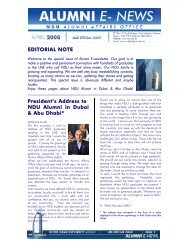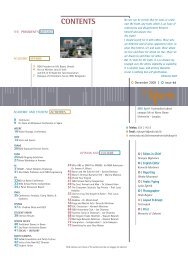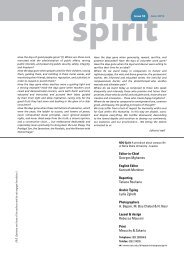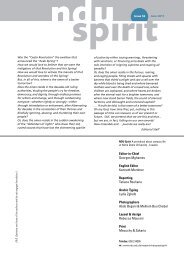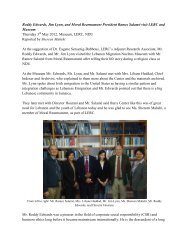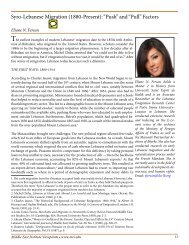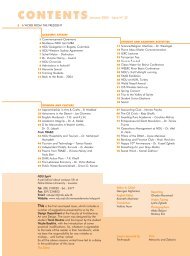OUTLINE - Notre Dame University
OUTLINE - Notre Dame University
OUTLINE - Notre Dame University
You also want an ePaper? Increase the reach of your titles
YUMPU automatically turns print PDFs into web optimized ePapers that Google loves.
But what about his proposal?<br />
Early in the 1990’s,<br />
Dr. Querci, his wife (an<br />
astronomer too!) and a<br />
certain Moroccan<br />
astronomer proposed a<br />
network of telescopes the<br />
purpose of which was to<br />
study the variability of<br />
stars. His proposal<br />
stemmed from the fact<br />
that stars vary over many<br />
timescales ranging from<br />
minutes to years and a<br />
proper understanding of<br />
the complex behaviour of<br />
stars requires a long-term<br />
study covering all these<br />
timescales. Unfortunately,<br />
this cannot be achieved<br />
with existing observatories<br />
for many reasons. You<br />
cannot expect to get two<br />
years of exclusive time on<br />
an 8-m telescope. The<br />
most you can obtain is<br />
four nights, and even<br />
then only if you have an<br />
extremely good proposal.<br />
And then, the observatory<br />
of your choice will be<br />
located on a mountain<br />
where night lasts for just a<br />
few hours. So what would<br />
you be doing during the<br />
day while watching for<br />
the variation of your star?<br />
Now here comes the trick.<br />
Set up for yourself a number<br />
of different telescopes<br />
at different longitudes<br />
such that, when the Sun<br />
rises on one of them,<br />
another has already started<br />
observing! Now this<br />
explains the “N” in<br />
NORT. What about the<br />
Oriental part? A study<br />
shown to the audience<br />
during his conference<br />
demonstrates that our<br />
dear part of the map has<br />
excellent observing conditions.<br />
Water Vapor is low<br />
= less clouds = more clear<br />
nights. We have high<br />
mountains, from the Atlas<br />
range to the mountains of<br />
Lebanon and on to the<br />
Himalayas. All these fall<br />
very close to the Tropic of<br />
Cancer, in a region rich<br />
with an old Islamic tradition<br />
of astronomy! So far<br />
so good for the Oriental.<br />
In some of these places<br />
you may well have more<br />
than 300 clear nights a<br />
year. Now compare this to<br />
about 160 nights for observatories<br />
located on the<br />
continent of Europe and<br />
you get the picture. To be<br />
able to make full use of all<br />
clear nights a robotic telescope<br />
is the obvious<br />
choice. It will be equipped<br />
to detect bad weather<br />
conditions and it will<br />
know what to do each<br />
and every night.<br />
One other interesting<br />
argument presented by<br />
Dr. François Querci has to<br />
do with a less well-known<br />
form of pollution, namely<br />
light pollution. The audience<br />
was presented with<br />
satellite images showing<br />
Europe and North Africa<br />
at night. The contrast is<br />
impressive. Whereas<br />
Europe is covered with<br />
lights, North Africa is<br />
essentially dark! A boon<br />
for astronomers! It was<br />
also impressive to see projections<br />
for Italy based on<br />
past satellite images and<br />
to notice that basically<br />
within twenty-five years<br />
Europe will have no place<br />
left where you will be able<br />
to enjoy a starry night.<br />
The other part of the talk<br />
was about the benefits<br />
that would be derived<br />
from the advancement of<br />
Astronomy and Space<br />
Science in developing<br />
countries. From transfer<br />
of technology to science<br />
education and formation<br />
of scientists and other<br />
qualified personnel, this<br />
would provide a basis<br />
enabling us to contribute<br />
to international space<br />
exploration and to international<br />
research. Putting<br />
us back on the science<br />
map of the world is the<br />
key idea. The speaker<br />
therefore presented an<br />
overview of current projects,<br />
ongoing or under<br />
study. Libya for example<br />
is currently commencing<br />
studies for a 2.3-m telescope<br />
(size is given for the<br />
main mirror.) Gulf countries<br />
for their part are considering<br />
the possibility of<br />
a regional observatory.<br />
Iran has joined the NORT<br />
and plans a 2-m class<br />
observatory, while<br />
Lebanese astronomers<br />
have proposed a 1-m class<br />
observatory to be installed<br />
on one of the higher<br />
peaks of our mountain<br />
range.<br />
After Dr. Querci’s talk, we<br />
all met for lunch at the<br />
NDU Cafeteria. Three<br />
Lebanese universities<br />
were represented around<br />
the table, namely NDU,<br />
the Lebanese <strong>University</strong><br />
and USJ. This all goes to<br />
show that astronomy is<br />
now a popular subject in<br />
Lebanon and that its<br />
development can, and<br />
should be, a national<br />
inter-university project. N<br />
26 NNU SPIRIT



